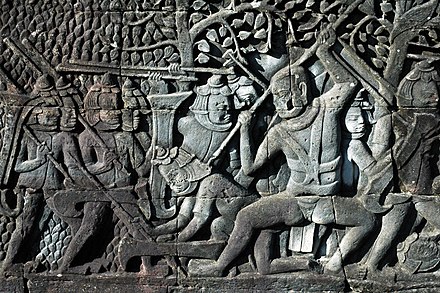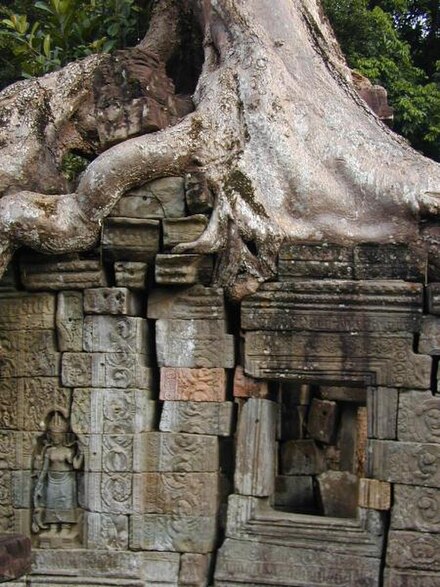Angkor Archaeological Park - former capital city; region of Cambodia
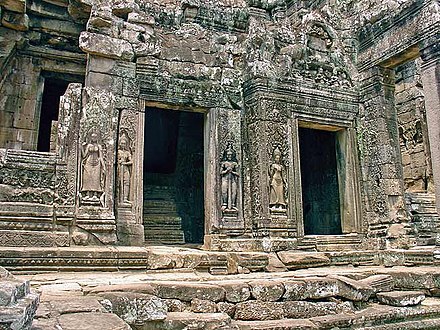 Angkor Archaeological Park, near Siem Reap in northern Cambodia, is one of the most important archaeological sites in Southeast Asia.
Angkor Archaeological Park, near Siem Reap in northern Cambodia, is one of the most important archaeological sites in Southeast Asia.
Understand
Stretching over 400 km², including forested area, Angkor Archaeological Park contains the magnificent remains of several capitals of the Khmer Empire of the 9th to the 15th centuries, including the largest pre-industrial city in the world. The most famous are the Temple of Angkor Wat and, at Angkor Thom, the Bayon Temple with its countless sculptural decorations.
Angkor Archaeological Park was declared a UNESCO World Heritage site in 1992. At the same time, it was also placed on the List of World Heritage in Danger due to looting, a declining water table, and unsustainable tourism. UNESCO has now set up a wide-ranging programme to safeguard this symbolic site and its surroundings.
Angkor has no accommodations and few facilities; the nearby town of Siem Reap, 6 km south, is the tourist hub for the area. You will likely be refused entry to certain sites, such as the highest tier of Angkor Wat, if you are deemed not to be dressed appropriately. This means your shoulders and knees should be covered: a scarf over your shoulders may not be accepted.
Symbolism
The temples of Angkor are highly symbolic structures. The foremost Hindu concept is the temple-mountain, where the temple is built as a representation of the mythical Mount Meru: this is why so many temples, including Angkor Wat, are surrounded by moats, built in a mountain-like pyramidal shape and topped by precisely five towers, representing the five peaks of Mount Meru. The linga (phallus), representing the god Shiva, was also critical and while the lingas themselves have largely gone, linga stands (carved, table-like blocks of stone) can be found in many if not most rooms in the temples. There was also a political element to it all: most kings wanted to build their own state temples to symbolize their kingdom and their rule.
While early Angkor temples were built as Hindu temples, Jayavarman VII converted to Mahayana Buddhism c. 1200 and embarked on a prodigious building spree, building the new capital city of Angkor Thom including Bayon, Ta Prohm, Preah Khan and many more as Buddhist structures. However, his successor Jayavarman VIII returned to Hinduism and embarked on an equally massive spree of destruction, systematically defacing Buddhist images and even crudely altering some to be Hindu again. Hinduism eventually lost out to Buddhism again, but the (few) Buddha images in the temples today are later Theraveda additions.
One element that continues to mystify archaeologists is the baray, or water reservoir, built in a grand scale around Angkor: for example, the West Baray is a mind-boggling 8 km by 2.3 km in size. While it has long been assumed that they were used for irrigation, some historians argue that their primary function was political or religious. Not a single outlet has been found, either by eye or by NASA imaging. The moat around Angkor and the West Baray still contains water, but the rest have dried up.
Motifs
As you tour the temples, you will see certain mythical figures and other motifs cropping up repeatedly.
<gallery> Image:Apsara Double Close.JPG|__Apsara__<br>_Celestial nymphs, always bare-breasted and usually dancing, representing an ideal of female beauty._ Image:Carving Kala.JPG|__Kala__<br>_Monstrous face without a lower jaw, often found on temple gateways, meant to guard against evil._ Image:Statue Naga.JPG|__Naga__<br>_Many-headed mythical serpent. The most famous Nagas' in Angkor can be found on the guardrails of each entrance to Angkor Thom._ </gallery>Climate
Angkor is hot and sticky throughout the year, but the peak season is November to February, when the weather is dry and temperatures are coolest (25-30°C). The flip side is that the temples are packed, especially around Christmas and New Year's, and hotel rates are at their highest. March to May is brutally hot, with temperatures reaching 40°C. June to October is the rainy season, and outlying temples and the roads leading to them can turn into quagmires of mud. However, this is also when the temples are at their quietest, and it's still often possible to do a good half-day round of sightseeing before the rains start in the afternoon.
Get in
Angkor is about 20 minutes to the north, by car or motorbike, from central Siem Reap. See the Siem Reap article for details on getting to the town. See "Get around" below for details on getting from the town to the Angkor.
Fees and permits
Non-Cambodian visitors must purchase an Angkor Pass to enter Angkor Archaeological Park. 1-day (US$37), 3-day (US$62), or 7-day (US$72) passes are available (prices as of Nov 2022). Until the end of 2022, 1-day passes are valid for 2 days, 3-day for 5 days, and 7-day for 10 days. You can pay by credit card or by cash (US dollars or riel, though the exchange rate provided isn't attractive: 156,000 riel for the 1-day pass in 2018). The 3-day pass is valid for any 3 days within a week, while the 7-day pass is valid for any 7 days within a month. Children under 12 may enter for free by presenting their passport; ID is not requested of visitors paying the full fee.
Make sure you purchase your Angkor Pass only at the official APSARA ticket office just off the highway from Siem Reap a couple of kilometers from the southern park entrance. Passes cannot be purchased from any other source, including tour operators, or online. If you enter the park on the road from the airport (east checkpoint) or Banteay Srei (north checkpoint), only 1-day passes are available.
For any pass, a photo is taken and printed on your Angkor Pass, so do not purchase one second-hand from someone else. Passes are checked at almost all sites within the park, including even some washrooms, so make sure you carry it with you at all times. And don't lose it, or you'll have to go back to the ticket booth to buy another.
Passes issued after 17:00 each day can be used to enter the park without counting as use of a day on your pass, as they are valid for the next day. However, the sale of Angkor Passes end at 17:30.
Cambodian citizens and holders of K visas (for people born in Cambodia or with a Cambodian parent) are allowed to enter the park for free (but K visa holders may still have to check in at the ticket office). Guides and drivers who are Cambodian do not need a pass as they can enter for free.
Get around
Generally speaking, two half-day tour options are offered, sun-rise (ends at the hottest time of day) and late morning (which includes sunset). Both last 4-6 hr depending on your tour.
Tour buses feature guided, air-conditioned comfort but also are subject to large crowds and lack of options. Be sure you know which temples are being visited as some of the larger buses only go to the 2 or 3 main tourist attractions, and leave out important "secondary" sights. The cost is US$25–70/day including driver and guide.
Cars with drivers can be hired for single or more days. While all drivers are familiar with the area and happy to suggest good routes, most speak little English and are not actual tour guides. For an actual licensed tour guide, the charge varies from US$45-50/day for a driver and English-speaking guide. It is customary for the drivers to ask for US$5-10 extra for trips to further temples such as those of the Big Circuit, Banteay Srey and more for remote sites like Beng Mealea.
Motorbikes (with drivers) can be arranged through any guesthouse for about US$6–8/day. Again, drivers might ask for more to visit remote ruins. Some drivers can speak a bit of English, and can give you information about Angkor and Cambodian life. Drivers are required to be licensed and must wear their gray numbered vest while travelling within the confines of the Angkor park. The rental of motorbikes without a driver to foreigners in Siem Reap is discouraged and if stopped by a police officer, he or she will inform you that renting a motorbike is prohibited. This is not completely true. Motorbike rental places do exist in the city and their numbers are increasing. The rate varies depending on the engine size. The cheapest motorbike rental is around US$6 per day for an electric-powered. Gas-powered motorbikes start at around US$8. Always use a helmet because it is required by law and riding without it will give a police officer a reason to flag you down. Not all locals use helmets, but they do avoid being visible to police officers on duty.
Tuk-tuks can be arranged through guesthouses, offering space for 1-4 travellers. Figure on ~US$15 for the main Angkor temples, and US$20-30 for outlying temples. Like the motorbike drivers, they must be licensed, may speak some English and must wear grey numbered vests while travelling within the park. Some drivers will add a US$3 extra fee if you would like to see sunrise at Angkor Wat (start the tour at 05:00 instead of 08:00).
Bicycles are a very convenient option to visit Angkor Wat and Angkor Thom, the little circuit or even the big circuit - depending on time you have and how big fan of Khmer temples you are. Renting a bike in Siem Reap is easy and cheap (US$1 per day, in most of places you don't even have to leave passport, locks for bikes are provided, check the bike before and ask for some amendments if needed, e.g. pumping air, oiling the chain). Most bike rental shops seem to open at 07:00, so if you want to get a really early start, rent a bike the day before, or arrange it with your hotel or hostel. It is about 6 km from the city to Angkor Wat (if you go first time, make sure you go by the Visitors Centre which is the only place where you can buy passes, and isn't on the main road to the temples). In the little circuit most places are at most 15 minutes away from each other by bike, so it is actually not a problem for a regular tourist (without much biking experience) to visit Angkor Wat, Angkor Thom and spots on the little circuit in one day. If you are willing to get up early and start your trip at 06:00 it won't be a problem to visit all above plus the big circuit (where spots are 30 minutes away each other by bike) in one day. Take into account your shape and visiting preferences. If you bike a lot at home - you can easily get around much quicker. If you enjoy Khmer architecture more than the typical Angkor visitor, it is recommended you reserve at least 3 days for the trip (it doesn't matter if you go by tuk-tuk or by bike). It gets hot, so be prepared to sweat buckets! It is a good idea to take a lot of water with you, rent a bike with a basket, but not a big problem if you run out of it during your trip. Around every temple in Angkor park you can buy some food and drinks (it's just more expensive than in the city, about US$2 per big bottle of water in the park). Cycling in Angkor Park is safe (traffic is low), pleasant (nice views and a lot of trees providing shadows in sunny days) and, last but not least, it saves you a lot of hassle of dealing with tuk-tuk drivers. You can't bring the bike onto the island of Angkor Wat, so expect to still be doing a fair amount of walking.
Electric cars will take you to certain areas for a round-trip price of only US$2. They can be found in front of Angkor Wat and the Terrace of the Elephants.
Helicopter flights are another way of seeing Angkor Archaeological Park. You can also visit outlying temples like Banteay Chhmar, Boeng Mealea, Koh Ker, Rolous Group, Phnom Bok & Tonle Sap floating village. Helistar Cambodia have prices starting from US$90 per person for the basic Bangkeng Mountain, Angkor Wat. Sras Srang, Pre Rup, Eastern Mebon and Ta Som 14-minute tour. Flights depart daily from the Military Apron, Siem Reap International Airport. Bookings essential and can be made through hotels or travel/tour agents or direct on +855 12 449 555 .
See
Guides can be hired for about US$20 a day and are available for most major languages. Hiring a guide for at least the first day can help you get orientated to the temples and are particularly useful for finding and explaining the bas-reliefs, which can otherwise be rather overwhelming and/or difficult to understand. Guide books are also useful.
Ancient Angkor, a guidebook that is hawked at every temple, is surprisingly good. Particularly if you are interested in the carvings on the walls and towers, the book will keep you occupied for hours. If you don't want to pay money to hear a local tell you about the temples in broken English this is a good option. Authored by Michael Freeman and Claude Jacques, the cover price is US$27.95 at bookstores. Brand new copies are sold by vendors for US$14 but you can easily haggle to US$6 or US$7, and the price amazingly drops to US$1 by the end of the day, even in peak season.
The Angkor Panorama Museum, beside the ticket office, is closed (Feb 2020) because of international sanctions against North Korea, which built and operated the museum.
Be sure to get to the temples early. You can enter the park beginning at 05:00; the temples open at sunrise. There are fewer visitors early in the morning, and the sun isn't at full force. Arriving at the temples at 08:00 instead of 09:00 can make all the difference in staying one step ahead of the crowds.
The temples can broadly be categorized into four groups:
- Angkor Wat and Angkor Thom, the grandest temples of all and the ancient capital next to it
- Little Circuit (Le Petit Circuit), taking in major sites to the east of Angkor Thom
- Big Circuit (Le Grand Circuit), taking in major sites north and further east
- Roluos group, 15 km east of Siem Reap along National Hwy 6
- Outlying temples, over 20 km from Angkor Wat
You can, of course, mix and match freely, but as distances are fairly long, it makes sense to plan ahead and pick sites connected by road. Most car, tuk-tuk or moto drivers will have an itinerary ready if you don't have one in mind, and their expertise may come in handy for arriving at sites a step ahead of the big tour groups.
Angkor Wat
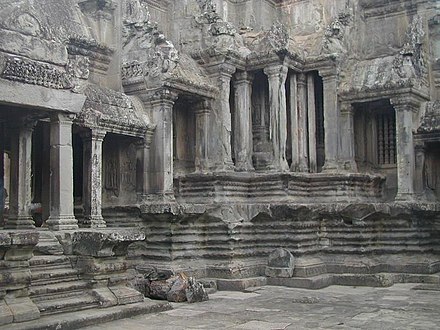
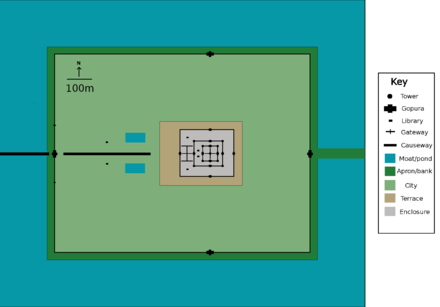
History
Located 6 km north of Siem Reap, Angkor Wat is one of the largest of Khmer monuments. Built around the first half of 12th century by King Suryavarman II, the temple's balance, composition and beauty make it one of the finest monuments in the world.
Though "wat" is the Khmer (Cambodian) word for temple, the westward orientation of the structure is atypical of temples. Scholars believe that the architecture and sculptures are that of a temple where Lord Vishnu was worshipped but it was also built as a mausoleum for the king after his death.
How to explore
Do your homework first. To enjoy the ruins, read articles on the sites, not just the history but also the spatial relationships and the hierarchy of importance of the ruins. The JASA Office (Japan Apsara Safeguarding Authority, a Japanese government agency) has an information office, the Bayon Information Center in Siem Reap along Sivatha Blvd (at the back of Hotel Le Meridien Angkor). It provides a bird's eye view of the story of Angkor Wat via DVD screenings and display storyboards in English for US$2 and for another US$5, a handy, concise and very enlightening graphic booklet (in color and perfect professional-level English) is available.
The size of the monuments makes it look overwhelming when one encounters it for the first time. The following is one of the suggested plan to explore Angkor Wat. Enter through the west entrance. When you reach the entry tower, walk to the right to get a glimpse of all the five towering gopuras.
Passing the tower and the libraries on both sides of the walkway, climb down the steps towards the left side and get to the water basin. You can catch a glimpse of the temple and its reflection in the water. Go past the basin and reach the left end of the temple.
You would by now have reached the starting point of the famous bas reliefs depicting scenes from various mythological stories and historic events. Walking from left to right you will come across scenes from battle of Ramayana, battle of Mahabharata, army of Suryavarman II, scenes from judgment by Yama (the supreme judge), churning of ocean by demons and gods to get Amrita — the nectar of immortality, Vishnu's victory over demons, victory of Krishna over Bana and other scenes of battle between gods and demons.
Climb the steps to reach the second tier. You can reach the third tier and the central courtyard within by climbing a set of wooden steps with a handrail on the eastern side. All other stairways to the third tier are closed. You will likely have to wait in line if there are a lot of other visitors present, and you will not be allowed entry if your shoulders are exposed or your shorts or skirt are seen as too short. Placing a scarf over your shoulders is not accepted, but you're of course very welcome to buy a T-shirt from the vendors just outside the temple on the northwest side.
When to visit
The sight of the grand monument towering over the landscape is breath-taking at any time of day. However, to maximise the effect, make your first trip to Angkor Wat in optimal lighting conditions, usually around 13:00-14:00. Sunrise at Angkor Wat is an also great sight to witness, so most of the tourists tend to see the sunrise at Angkor Wat, then explore other ruins in the morning and return to Angkor Wat later in the afternoon. The sun rises behind Angkor Wat and the best colors are seen just before the sun climbs into view. As the position of the sun as it rises varies according to the time of year, position yourself accordingly. For example, in November–December when you are facing Angkor Wat, the sun rises on your right hand side. Grab a place to the extreme left of the entry tower to see the sunrise. Sunset at Angkor Wat is best viewed either on the top tier or outside the main temple structure.
Angkor Thom
Bayon
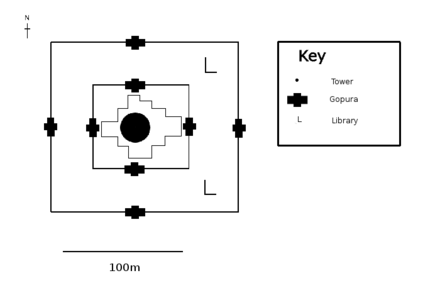
History
Built in the latter part of the 12th century by King Jayavarman VII, Bayon is one of the most widely recognised temples in Siem Reap because of the giant stone faces that adorn the towers of Bayon. There are 54 towers of four faces each, totaling 216 faces. There is still a debate as to who is being depicted in the faces. It could be Avalokiteshvara, Mahayana Buddhism's compassionate Bodhisattva, or perhaps a combination of King Jayavarman VII and Buddha.
How to explore
Bayon's plan can be divided into three levels — the first two are bas-reliefs and the uppermost consists of the central sanctuary. The outer gallery depicts scenes from everyday life and historical events, while the second inner gallery depicts mythical figures and stories. In total, there are more than 1 km of bas-reliefs to be viewed in the Bayon.
Enter Bayon from the east. The outer gallery comes into view first. The second gallery is on the next higher level. The third level is where you will encounter many of the famous faces (and tourists). The fact that these stones are exposed to direct light makes it easy to shoot pictures throughout the day, though mid-day sun eliminates shadows. You will find fewer tourists too during this time of day.
When to visit
The surrounding and the tall towers makes Bayon a bit dark and flat for study and photography near sunrise and sunset. Hence, it is best to visit Bayon when there is plenty of light. 10:00 to around 16:00 is the stretch most people prefer.
Baphuon
To the northwest of the Bayon, the Baphuon is supposed to represent Mount Meru (sacred to Hinduism), and was one of the largest and grandest structures in Angkor. Built into the western face of the Baphuon is a giant reclining Buddha, added in the 16th century after the region converted from Hinduism to Buddhism.
Archaeologists had dismantled the Baphuon to perform renovation when they were interrupted by the civil war; the records for piecing the temple back together were subsequently lost or destroyed. Today the reconstruction work is done, so visitors can now walk up to the topmost tier.
Other Angkor Thom sights
The Bayon and Baphuon temples form only part of the giant ancient city of Angkor Thom, once thought to hold a population of one million.
In addition to the Bayon and Baphuon temples, the ancient city of Angkor Thom holds a number of other sites of interest:
- The Terrace of the Elephants. A platform attached to the ruins of Phimeanakas famous for its elephant carvings, which was used by King Jayavarman VII to view his victorious armies returning to the ancient city.
- The Terrace of the Leper King. In the corner of the Royal Square of Angkor Thom, this terrace is associated with Dharmaraja. Depicting the image of the Hindu god Yama, it may have been used as a cremation site.
- Five entrance gates, one at each ordinal compass point and the Victory Gate in the east wall. The west and the north gates are free from tourists. Each of the gates is topped by the face of Avalokitesvara. There is a path on top of the walls, and one along the outside wall, that can be followed to walk from gate to gate. The total walk is around 13 km, about 3.5 hours long. As of March 2012, the path has been closed due to collapses in the walls.
- Phnom Bakheng. The first temple-mountain constructed in Angkor, with a commanding hilltop location, is under renovation as shown by the cranes hauling piece by piece the stones out from the structure. Extremely popular (and crowded) spot for sunsets: allow half an hour for the sweaty hike to the top, and leave early or bring a torch for the way back. The final climb to the top of the temple is steep and dangerous at dark. The sun does not set over Angkor if seen from here, and any visible temples are in fact quite far away. You are not allowed to climb Phnom Bakheng after 17:30 - hence make sure you arrive earlier. An elephant ride back down the hill will cost US$15 per person.
Little Circuit
Clockwise order, exiting Angkor Thom by the Victory Gate:
- Ta Keo. An incomplete, largely undecorated temple built by Jayavarman V. The stairs at the east side of the monument are least steep and the easiest way to reach the top level.
- Ta Prohm. Built during the time of king Jayavarman VII and is best known as the temple where trees have been left intertwined with the stonework, much as it was uncovered from the jungle. It might be considered in a state of disrepair but there is a strange beauty in the marvelous strangler fig trees which provide a stunning display of the embrace between nature and the human handiwork. This is one of the most popular temples after Angkor Wat and the Bayon because of the beautiful combinations of wood and stone. Black and white film photographers especially love this site because of this and most of the stunning postcard shots of Angkor's trees come from here. A few scenes from Angelina Jolie's Tomb Raider were filmed here. While the temple is very popular, most visitors follow a central route and the sides of the complex can be surprisingly quiet. Large sections of the temple are unstable rubble and have been cordoned off, as they are in real danger of collapse. Restoration of Ta Prohm has included removing plants, and some trees. Parts of the temple have been rebuilt, and wooden walkways run through the site, providing date access for visitors, and ruining photos.
- Banteay Kdei. Sprawling Buddhist monastic complex in the style of Ta Prohm. Its name means A Citadel of Chambers, but it is also known as Citadel of Monks' cells. In poor shape, but slowly being restored.
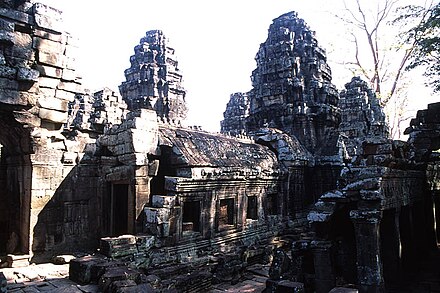
- Sras Srang. Terrace leading to a pond. Located right across the road from Banteay Kdei.
- Prasat Kravan. A little temple to end the little circuit.
Big Circuit
In clockwise order, exiting Angkor Thom by the North Gate:
- Preah Khan. Jayavarman VII's first capital, before the completion of Angkor Wat. Large and atmospheric, yet somewhat overshadowed by Angkor Wat and Ta Prohm, this temple is partly in disrepair with strangler figs crawling up the walls, but has some excellent carvings and fewer visitors, and is well worth a visit. The temple is some 3 km north of Angkor Thom.
- Neak Pean. Not really a temple, this is an interesting quick stop. It consists of four ponds surrounding a large pond that has a tower in the middle. This complex is accessible via a 200-meter-long wooden causeway that cuts across the pond.
- Ta Som. A small temple worth the stop for its well preserved gates and an impressive strangler fig surrounding its far eastern door.
- East Mebon. Sitting on what was an island in the now dry East Baray, this is a large, three-story temple-mountain crowned by five towers, like a miniature Angkor Wat. It was built by Rajendravarman II in the 10th century. Many structures are in poor shape, but the temple is best known for its massive (restored) elephant statues. 2022-02-06
- Pre Rup. A temple-mountain close to and quite similar in style to East Mebon, and constructed only a decade later. Like East Mebon, Pre Rup is largely built from brick, rather than sandstone. A popular spot for viewing the sun set into the jungles and rice paddies of the Cambodian countryside. 2020-02-03
Roluos group
The ruins here are from the ancient capital of Hariharalaya, dating from the late 9th century and thus predating Angkor.
- Bakong. A five-terraced pyramid in the mountain-temple style.
- Lolei. An island temple constructed in a baray, now dry.
- Preah Ko. The first temple to be built here, dating from the 9th century.
Outlying temples
- Banteay Srey, 37 km north of Angkor Wat. This red colored temple is well known for its intricate carvings, and is worth a half-day trip on its own, since it is a bit further from Siem Reap than the main Angkor Thom and Angkor Wat areas. Car and motorcycle drivers will charge a bit extra (US$10) to take you to the temple.
- Kbal Spean. 5 km north of Banteay Srey. After the man-made monuments of the temples, it can be nice to get back to nature for a while. Also known as the site of 1,000 lingas, the numerous submerged carvings on the rocky river bed may fall short of that number, but it makes for a pleasant walk along the river to a small but attractive waterfall. The 1500-m walk through rainforest past, precariously perched boulders and creeping vines is not too hard but requires a modicum of fitness and care, since some scrambling over rocks are needed, and especially if wet weather has made the steeper sections slippery. There are forks in the trail where the path is not well marked, but one can follow the general rule of climbing up or wait for passing visitors to ask for directions. Drier weather means less water, or none (for example, during the dry season of Jan-Feb), and easier viewing of the carvings. Best combined with a trip out to Banteay Srey.
- Beng Mealea, 80 km east of Siem Reap, about 1½ hr by car. Along with Ta Phrom and others, this is a temple which has been left to nature, but unlike Ta Phrom only a few trees have been removed. The trees and creepers that reduced this smaller version of Angkor Wat to ruins are still growing out of walls, and hanging over ruined buildings. This site is great for some atmospheric photos. Much of the route is along wooden boardwalks, although in a couple of places you have to clamber over walls. This can be taken in as part of a trip to the Roluos Group, or a long day trip with Banteay Srey and Kbal Spean, though this will entail about 5 hours travelling in total on some very rough roads. It is included in the Angkor Pass. Bus tours from Siem Reap will cost US$28 per person, or a travel agent can arrange a private car for US$45 for 2-3 people (Feb 2020).
- Phnom Krom, 12 km southwest of Siem Reap. This hilltop temple was built at the end of the 9th century, during the reign of King Yasovarman. The gloomy atmosphere of the temple and the view over the Tonle Sap lake make the climb to the hill worthwhile. A visit to the site can be conveniently combined with a boat trip to the lake. The Angkor Pass is needed to enter the temple so do not forget to bring your passport along when heading to Tonle Sap.
Buy
Souvenirs are also sold in front of all temples. Bargain, but not too hard: many souvenir sellers live within the park and, being banned from farming on their own land, have to resort to this to make a living. Please do not encourage children who pester tourists in the temples themselves to give money or buy postcards. Spread your tourism dollars around—most temples have the same offerings, so buy your souvenirs and gifts for friends back home from several shops, from several temples if possible, especially the less-visited ones.
Ancient Angkor, a guidebook that is hawked at every temple, authored by Michael Freeman and Claude Jacques; the cover price is US$27.95 at bookstores. Brand new copies are sold by vendors for US$14 but can be sold for as little as US$1 in the afternoon without haggling. Alternatively, the book is available for rental online for free through the Internet Archive.
There are several decent souvenir shops around the old market. The one of the shops called "Black Garuda" has some original key holders and mobile straps and they donate some of your purchase to land mine victims.
Eat
Despite a ban on development and commercial activity, dozens of small noodle and snack shops have sprung up near the major attractions of Angkor Wat and Angkor Thom. The listed prices are high (US$4–7 for mediocre food), but shopkeepers may be willing to bargain. During summer low season, you can bring the price of a good lunch down to as low as US$1 for a dish and US$0.50 for a drink. Their flocks of five year old emissaries aren't likely to hold price-cutting authority. However, avoid hard or aggressive bargaining, either because the odd dollar is nothing to you but can be significant to a local, and also it is unwise to offend or upset anybody before they prepare your meal! You'll also find some local people selling fresh pineapples and mangoes (beautifully cut) and bunches of little bananas for about US$1 a piece. Also try the seasonal toddy palm fruit, a hollow sack as soft as jelly at 4 pieces for US$1 sold at the roadside to Bantay Samre and at temple refreshment stalls.
If a tuk-tuk driver brings you to a restaurant, he gets a commission – which means you'll be paying more for the meal and it won't be easy to bargain. Try to find a restaurant yourself and it'll be much easier to get an inexpensive meal.
- The modern Angkor Cafe lies just outside Angkor Wat's main entrance, and also doubles as a crafts shop, with fine works from the Artisans d'Angkor shop, where they train locals in the arts. Their prices are on the high side for Cambodia, but very reasonable for Western pockets (mainly US$3–5) with excellent food, nice decor and air conditioning.
Drink
Soft drinks are hawked by stalls in front of practically every temple. As you might expect, prices are inflated: US$1 for a can of soft drink look to beer, or two cold 500-ml bottles of water is more or less standard; $2 is not uncommon (Feb 2020).
In warm weather, the temples are extremely hot and it may be worth buying and carrying large bottles of water.
Sleep
There are no accommodations within the park, and camping is not permitted. Like most tourists you will find yourself staying in Siem Reap, with a multitude of options ranging from grubby little guest houses to upmarket hotels and villas. See Siem Reap for more details on accommodation options.
Stay safe
By local regulation, motorcycle and tuk-tuk drivers must at all times wear a numbered vest when on the job, which goes a long way towards preventing hassles and scams. However, a disturbing number of rapes continue to happen, especially after dark and in the more secluded temples, so it's advised that women not travel alone.
Visiting the temples, beware of off-duty police officers, in uniform, who start walking beside you and start showing you around the temples. At this point either say that you would like to see the temples yourself, or agree on a price at the start. Several people have been charged a fee of over US$10 at the end of the temple tour and you are not going to argue with a member of the police force. The official wage for a police officer is very low, so they can easily double their salary by being tourist guides.
Beware of anyone offering you incense. They will hand you the incense and then "teach" you a blessing. They will then ask for a donation (generally about US$10) for the monks and the upkeep of the temple. None of the funds will make it to either of these causes, so it's best just to say a quick "No thank you" when they try to give you the incense in the first place.
Tourists mulling over whether to rent a tour bike: have no fear. Parking is never a problem and not in the warden’s wildest dream that a bike parked besides an attraction will get lost or stolen, locked or not. In small temples it surely is easy to park and leave. Bikes are parked across the west entrance and vendors will even compete for your attention to babysit your bike. During biking trip be aware of children standing by the roads in Angkor Park and raising their hands to give you high fives. Stay on the safe side and just wave your hand, as sometimes they try to take a ring off your fingers when you give them a high five.
Be prepared for vast numbers of peddlers who linger around temples. It may feel difficult or rude to ignore the constant come-ons to buy souvenirs, photocopied guidebooks, T-shirts, and assorted junk, but it can be necessary in order to enjoy your visit in semi-peace.
Stay healthy
Touring the temples is a hot and sweaty job, so bring sunblock and keep yourself well hydrated. Some of the temples, notably the uppermost level of Angkor Wat, require climbs up very steep staircases and are best avoided if you suffer from vertigo or are not fully confident of being able to keep your footing.
Malaria is not endemic around the temple complex; however, it is recommended to seek medical advice before you travel as conditions may change.
Don't feed or approach the monkeys who lurk around some sites: many are ill-tempered and will bite at the slightest provocation.
Respect
Some of Angkor's sites were built as Hindu temples, while some were built as Buddhist temples, and yet others were converted over the years. Today, most of Angkor's major temples house at least a few Buddha statues (nearly all added later) and draw a steady stream of monks and worshippers. You may be approached for donations, but these are like to be scammers, as genuine Theravada Buddhist monks are not allowed to touch money or solicit donations.
Because these are still holy spaces for Cambodians, you are asked to follow the dress code that the Cambodians follow when visiting any temple or holy space, meaning "long trousers or skirt, and covered shoulders." As of May 2019, a ban on exposed shoulders is being strictly enforced for the uppermost level of Angkor Wat, and possibly in some other spots too. Covering your shoulders with a scarf is not accepted, but you are of course welcome to buy a T-shirt from vendors just outside the temple. In other locations very near to active shrines of worship, you may be politely asked to leave if you don't conform to the dress code, but in most areas of the park, no one will say anything.
Angkor
Date Time:Please wait...Timezone:Asia/Phnom_PenhCoordinates:13.43, 103.83
Siem Reap
2nd-order administrative division
Siem Reap
Primary administrative division
